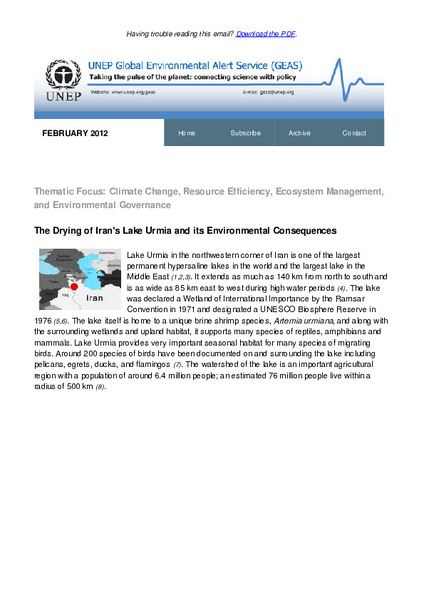The Drying of Iran's Lake Urmia and its Environmental Consequences - UNEP Global Environmental Alert Service (GEAS) February 2012

Date
2012-02Author
United Nations Environment Programme
Citation Tool
Bibliographic Managers
RT Generic T1 The Drying of Iran's Lake Urmia and its Environmental Consequences - UNEP Global Environmental Alert Service (GEAS) February 2012 A1 United Nations Environment Programme YR 2012-02 LK https://wedocs.unep.org/20.500.11822/40891 PB AB TY - GEN T1 - The Drying of Iran's Lake Urmia and its Environmental Consequences - UNEP Global Environmental Alert Service (GEAS) February 2012 AU - United Nations Environment Programme Y1 - 2012-02 UR - https://wedocs.unep.org/20.500.11822/40891 PB - AB - @misc{20.500.11822_40891 author = {United Nations Environment Programme}, title = {The Drying of Iran's Lake Urmia and its Environmental Consequences - UNEP Global Environmental Alert Service (GEAS) February 2012}, year = {2012-02}, abstract = {}, url = {https://wedocs.unep.org/20.500.11822/40891} } @misc{20.500.11822_40891 author = {United Nations Environment Programme}, title = {The Drying of Iran's Lake Urmia and its Environmental Consequences - UNEP Global Environmental Alert Service (GEAS) February 2012}, year = {2012-02}, abstract = {}, url = {https://wedocs.unep.org/20.500.11822/40891} } TY - GEN T1 - The Drying of Iran's Lake Urmia and its Environmental Consequences - UNEP Global Environmental Alert Service (GEAS) February 2012 AU - United Nations Environment Programme UR - https://wedocs.unep.org/20.500.11822/40891 PB - AB -View/Open
Item Statistics
Display item statisticsMetadata
Show full item recordDescription
Lake Urmia in the northwestern corner of Iran is one of the largest permanent hypersaline lakes in the world and the largest lake in the Middle East (1,2,3). It extends as much as 140 km from north to south and is as wide as 85 km east to west during high water periods (4). The lake was declared a Wetland of International Importance by the Ramsar Convention in 1971 and designated a UNESCO Biosphere Reserve in 1976 (5,6). The lake itself is home to a unique brine shrimp species, Artemia urmiana, and along with the surrounding wetlands and upland habitat, it supports many species of reptiles, amphibians and mammals. Lake Urmia provides very important seasonal habitat for many species of migrating birds. Around 200 species of birds have been documented on and surrounding the lake including pelicans, egrets, ducks, and flamingos (7). The watershed of the lake is an important agricultural region with a population of around 6.4 million people; an estimated 76 million people live within a radius of 500 km (8).
Collections
Document Viewer
To read more, scroll down below.

